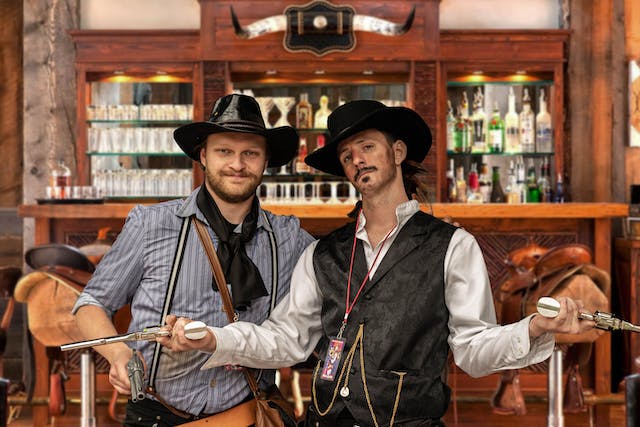
What are “Spaghetti Westerns”? They are Westerns that were filmed in Italy rather than the United States.
Westerns are movies that are set in the Wild West of America, and they generally feature cowboys and gunslingers. Western movies appeared almost as soon as silent movies appeared. The first real Western was The Great Train Robbery that was filmed in 1903. These Western movies were the logical next step of the Wild West show. These shows had been around since the 1870s and they reacted famous battles and featured many famous cowboys. Buffalo Bill was one very famous example. There was a love of the cowboy and famous cowboys were often romanticized. Dime store novels featuring cowboys and their adventures were extremely popular. These Wild West shows toured America, but the problem with a live show is that it can only be in one place at one time. Movies can be on every theater at the same time.
Western movies grew in popularity, but the Great Depression slowed production for a while. After the Depression was over (or at least on the slow path to mend), people started to watch movies again. Stagecoach, starring John Wayne, was the most popular movie of 1936. However, at this time, Hollywood and movies were going through a change. After the end of World War 1, people believed that Hollywood was becoming amoral. There were a number of scandals involving celebrities and people believed that Hollywood needed to be controlled. It is no coincidence that this coincides with prohibition in the United States. Highly vocal religious groups called for society to be brought back onto the straight and narrow. Hollywood realized that it needed to do something to avoid heavy government regulation and decided to self-regulate. The major film studios hired a Presbyterian elder called Wil H. Hays to come up with a list of guidelines and to clean up Hollywood’s image. His guidelines became known as the Hays Code, and they controlled Hollywood until the mid-1960s.
The Hays Code attempted to regulate anything that Hays believed society would deem inappropriate, such as nudity, violence, talk of drugs, and many other things. The film studios believed they were under threat, and they followed the guidelines religiously. American movies made in this era are very staid and sensible. That is great if you believe movies are a sign that society is falling apart. It is not so great if you like movies.
When World War 2 ended, Hollywood was making a lot of war movies and a fair few Westerns, but it was still governed by the Hays Code. The cost of movies was increasing, and they suddenly had to compete with a new media, that of TV. In 1948, 1% of Americans owned TVs and by 1955 75% owned a TV. Hollywood was governed by the Hays Code, but TV was not. You could show things on TV that would be banned in a movie theater. Foreign movies were also not governed by the Hays Code and could be far more risqué.
World War 2 had decimated Italy and people were trying to eke a living out among the ruined buildings. Italian film makers still wanted to make movies, but they had no money, no sets, and no real actors. They begged and borrowed to make very straightforward movies that made use of the natural scenery and normal people. They learned to make very good movies at a very low cost and very quickly. As well as this, after the war had ended, American culture and movies flooded the world. Westerns were hugely popular in Italy and directors there began to make them. They had the skills, and they also had the scenery because many places in Italy looks the deserts of the Wild West.
In the late 50s, Italian directors started to shoot American Western movies. They used locations in Italy, but also a lot of places in Spain. They didn’t have to follow the Hays Code, so their movies were darker and more violent. They used corruption, violence, desperation, and the antihero as themes. The Italians started to make as many Westerns as they could and over 20 years, they churned out more than 600 of them. Most of them were low-budget movies and the term “Spaghetti Western” was coined with a negative connotation. They used B-movie actors from America or actors who just needed to earn some money. Spaghetti Westerns might have stayed as simply low-budget movies if a TV star called Clint Eastwood hadn’t decided to make a movie called A Fistful of Dollars with an Italian director called Sergio Leone. This movie and the two that followed it, especially The Good, The Bad, and The Ugly, made Clint Eastwood into a huge star. They also became the standard by which all other westerns were judged. Spaghetti Westerns started out as movies made on a shoestring, but the styles that the Italian directors brought changed all Westerns. And this is what I learned today.
Photo by Kevin Bidwell: https://www.pexels.com/photo/two-men-standing-beside-brown-wooden-cabinet-2386728/
Sources
https://www.acmi.net.au/stories-and-ideas/early-hollywood-and-hays-code/
https://en.wikipedia.org/wiki/Hays_Code
https://www.npr.org/2008/08/08/93301189/remembering-hollywoods-hays-code-40-years-on
https://en.wikipedia.org/wiki/Western_film
https://en.wikipedia.org/wiki/Spaghetti_Western
https://www.almanac.com/fact/where-did-the-term-spaghetti-western-come
